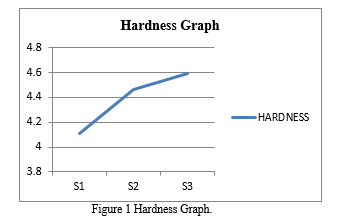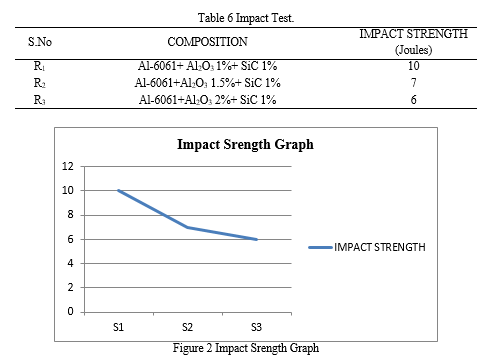Ijraset Journal For Research in Applied Science and Engineering Technology
- Home / Ijraset
- On This Page
- Abstract
- Introduction
- Conclusion
- References
- Copyright
Investigation of Mechanical Characteristic of Al2O3 and Silicon Carbide Microparticles Reinforced with Aluminum LM6
Authors: Mani R, Hariharan S, Srinivasan P, EdisonThangaraj J, Arunkrishnan M, Bala Subramanian G, Harish N
DOI Link: https://doi.org/10.22214/ijraset.2022.47679
Certificate: View Certificate
Abstract
Aluminum metal matrix composites are widely employed in a variety of applications due to their superior mechanical qualities when compared to their parent Al alloy. Stir casting was used to create an aluminum alloy (LM6) reinforced with 1, 1.5, and 2% Alumina (Al2O3) and 1% Silicon carbide (SiC) micro particles. Composites were first warmed and then blended with an aluminum alloy (LM6) before analyzing the mechanical characteristics of the Al-Al2O3-SiC composite.
Introduction
I. INTRODUCTION
The term composite refers to a fiber-reinforced "matrix" material. Metal matrix compositions (MMC) have emerged as prominent materials, with particles reinforced aluminium MMCs garnering particular interest because to their superior mechanical characteristics. MMC is a common composite material used in the aerospace, automotive, electronics, and medical sectors they possess exceptional mechanical qualities such as high strength, low weight, low ductility, great wear resistance, high thermal conductivity, and low thermal expansion. Metal-matrix composites (MMCs) can tolerate high tensile and compressive stresses because the applied load is transferred and distributed from the ductile matrix to the reinforcing phase. These MMCs are made by incorporating a reinforcement phase into the matrix using a variety of processes like as powder metallurgy, liquid metallurgy, stir casting, and squeeze-casting. Particulate-reinforced composites are less expensive than fiber-reinforced composites due to reduced fiber and production costs. Matrix composites are composite materials in which the majority of the material is a matrix and reinforcement is added to improve its qualities. The matrix is both continuous and uniform. The substance inserted in the matrix is known as reinforcement. Reinforcements can be introduced as monofilaments or in the form of discontinuous short fibers, whiskers, particles, and so forth. Metal matrix composites are composite materials that are made up of two phases: matrix and distributed. The reinforcing material has been included into the matrix. Various ways for manufacturing metal matrix composites have been developed, but the stir casting process is the most extensively utilized since it is easy and cost effective. Stir Casting is a liquid state process of fabricating composite materials in which a dispersed phase (ceramic particles, short fibers) is mechanically mixed with a molten matrix metal. The liquid composite material is subsequently cast using standard casting procedures and may also be treated using standard metal forming technology. The inclusion of the particles into the liquid metal and casting is a cost-effective method of generating metal matrix composites. The matrix phase in AMC is pure aluminium or an alloy of it, while the reinforcement is a nonmetallic ceramic such as SiC, Al2O3, SiO2, B4C, or Al-N. Aluminium alloys are becoming increasingly popular because to their excellent corrosion resistance, high damping capacity, low density, and electrical and thermal conductivities. Because of the difference in mechanical characteristics dependent on the percentage of reinforcement and chemical composition of the Al matrix, AMCs have been studied and proven helpful in several engineering fields including functional and structural applications. The downside of manufacturing AMCs is often the comparatively high cost of fabrication and reinforcing materials. The most cost-effective way of producing composites is critical for extending their applicability. Particulate-reinforced aluminum-metal matrix composites (AMCs) are garnering attention from academics because to their isotropic characteristics and inexpensive cost. With the development of new processing techniques, the stir casting process has shown to be a reasonably inexpensive and simple procedure. This research provides a comprehensive evaluation of stir cast aluminium matrix composites with better mechanical and tribological characteristics
II. MATERIALS AND METHODS
Selection of Materials
A. Alloy of aluminium (LM6)
LM6 is a corrosion-resistant aluminium casting alloy with excellent impact strength, ductility, and durability and strength. LM6 is difficult to produce due of its high silicon content. Simple features can be added with LM6, but not more complicated ones. LM6 is also one of the most bendable aluminium alloys. This is a critical property for many maritime applications, such as boat propellers, which must work effectively and with considerable malleability in severe conditions without breaking. General, electrical, maritime, intricately formed castings, and building cladding panels are among of the applications. LM6 is also often utilized in a variety of land applications where dampness and moisture are a concern.
Table 1 Properties of aluminum (LM6).
|
Content |
Sand Cast |
Chill Cast |
Die Cast |
|
0.2% of Proof Stress |
66-70 |
72-80 |
119 |
|
Tensile Stress |
168-190 |
190-229 |
276 |
|
Elongation (%)* |
5-10 |
7-15 |
2-5 |
|
Impact Resistance |
6 |
9 |
- |
|
Brinell Hardness Number |
55-60 |
60 |
60 |
|
Endurance Limit |
50 |
69 |
- |
|
Modulus of Elasticity |
72 |
72 |
72 |
|
Shear Strength |
125 |
- |
- |
B. Aluminium Oxide (Al2O3)
Aluminium oxide (Al2O3) is a chemical compound with the formula Al2O3 that is made of aluminium and oxygen. It is the most common of the several aluminium oxides and has been labelled as aluminium (III) oxide. It is commonly known to as alumina, although depending on its form or usage, it may also be referred to as aloxide, aloxite, or alundum. It occurs naturally as the mineral corundum in its crystalline polymorphic phase -Al2O3, from which the costly gemstones ruby and sapphire are formed.
Table 2 Properties of Aluminium oxide (Al2O3).
|
Content |
Values |
|
Molar Mass |
101.960 gmol-1 |
|
Appearance |
White solid |
|
Density |
3.987 g/cm3 |
|
Melting Point |
2072 0C |
|
Boiling Point |
2977 0C |
|
Solubility in Water |
Insoluble |
|
Log P |
0.31860 |
|
Thermal conductivity |
|
C. Silicon Carbide (SiC)
Silicon carbide (SiC) is a silicon-carbon semiconductor that is also known as carborundum. Moissanite is a naturally occurring mineral that is extremely uncommon. Synthetic SiC powder has been mass-produced as an abrasive. Sintering may fuse silicon carbide grains together to make exceedingly hard ceramics, which are frequently used in applications requiring great durability, such as automotive brakes, clutches, and ceramic plates in bulletproof vests.
Table 3 Properties of Silicon carbide (SiC).
|
Content |
Values |
|
Chemical formula |
SiC |
|
Molar mass |
40.096 g/mol |
|
Density |
3.16 g/cm3 |
|
Melting point |
2830oC |
|
Solubility |
Insoluble in water, soluble in molten alkali and molten iron. |
Table 4 Material Proposition
|
Ratio |
Al 6061 (Grams) |
Al2O3 (Grams) |
SiC (Grams) |
|
I |
550 |
1% - 5.5 |
1% - 5.5 |
|
II |
550 |
1.5% - 8.25 |
1% - 5.5 |
|
III |
550 |
2% - 11 |
1% - 5.5 |
III. EXPERIMENTAL PROCEDURE OF STIR CASTING
- Stir casting is a liquid state technique for creating composite materials that involves mechanically mixing a dispersed phase with a molten matrix metal. Stir casting is the most basic and least costly method of producing in a liquid state. Three reinforcement combinations are created using the aluminium metal matrix (1, 1.5, and 2 percent Al2o3 and 1 percent SiC).
- Al2O3 and SiC particles with average particle sizes (APS) ranging from 30 to 40 microns are added to the metal matrix. Silicon carbide and aluminium oxide are preheated at 600 K for 1 hour before being added to the melt.
- The Al 6061 was placed in a furnace designed particularly for liquid metal stir casting, complete with a bottom pouring mechanism. The amount of silicon carbide is the same in each matrix, but the amount of aluminium varies.
- A thermocouple has been placed, and it gives temperature feedback from the furnace. To restrict chemical interactions between the components, the temperature within the furnace is controlled about 850 degrees Celsius. By connecting the furnace's relay and the thermocouple, the temperature is controlled.
- To disperse silicon carbide and aluminium oxide particles in matrix alloy, mechanical stirring (using an electric motor-driven stirrer) is utilized. The warmed reinforcement particles are added to the melt and stirred at 200 rpm for 5 minutes.
- The dispersion of SiC and Al2O3 particulates in Al6061 matrix is found to be quite uniform, with few particle clusters.
- This indicates that the mechanical stir casting procedure used to create the composite is efficient. Strength is defined as the maximum stress that a substance can sustain under external forces (loads) without destroying it. The prepared sample has a diameter of 30 mm and a gauge length of 230 mm.
IV. RESULTS AND DISCUSSION
A. Hardness Test
Hardness is a measure of resistance to localized plastic deformation produced by mechanical indentation or abrasion. Some materials are harder to work with than others. Strong intermolecular interactions characterize macroscopic hardness, but the behavior of solid materials under stress is complex; hence, three types of hardness measurements exist: scratch hardness, indentation hardness, and rebound hardness. Hardness is influenced by ductility, elastic stiffness, plasticity, strain, strength, toughness, viscoelasticity, and viscosity. Conversion tables are useful for converting from one scale to another.
Table 5 Hardness Test.
|
S.No |
Material |
HRB |
|
R1 |
Al-6061+ Al2O3 1%+ SiC 1% |
41.1 |
|
R2 |
Al-6061+Al2O3 1.5%+ SiC 1% |
44.6 |
|
R3 |
Al-6061+Al2O3 2%+ SiC 1% |
45.9 |

B. Impact Test
Impact tests are performed to determine a material's toughness. Toughness is a measure of a material's capacity to absorb energy during plastic deformation. Brittle materials have low toughness due to the limited amount of plastic deformation that they can withstand. Temperature can also affect a material's impact value. In general, at decreasing temperatures, a material's impact energy decreases.

V. ACKNOWLEDGEMENTS
This research was funded by the Institution of VSB College of Engineering Technical Campus, Coimbatore, for this reason, the authors would like to thank the Institution of VSB College of Engineering Technical campus.
Conclusion
Stir cast processes were used to effectively create the Al-Al2O3-SiC composite. The inclusion of Al2O3 and SiC, which operate as effective reinforcement in the aluminium matrix for both procedures, boosted mechanical characteristics. The reinforcements improve the maximum mechanical qualities. The mechanical qualities of the aluminium alloy (LM6), such as hardness, wear, and tensile strength, are to be enhanced in this study as compared to pure aluminium alloy. The use of alumina reinforcing elements increases the hardness of the aluminium alloy. The reinforcement improves the ductility of the material while decreasing the impact strength.
References
[1] Vijian, P. and Arunachalam, V.P., 2006. Optimization of squeeze cast parameters of LM6 aluminium alloy for surface roughness using Taguchi method. Journal of Materials Processing Technology, 180(1-3), pp.161-166. https://doi.org/10.1016/j.jmatprotec.2006.05.016 [2] Suragimath, P.K. and Purohit, G.K., 2013. A study on mechanical properties of aluminium alloy (LM6) reinforced with SiC and fly ash. IOSR J. Mech. Civ. Eng, 8(5), pp.13-18. [3] Mishra, P., Mishra, P. and Rana, R.S., 2018. Effect of rice husk ash reinforcements on mechanical properties of aluminium alloy (LM6) matrix composites. Materials today: proceedings, 5(2), pp.6018-6022. https://doi.org/10.1016/j.matpr.2017.12.205 [4] Chelladurai, S.J.S., Arthanari, R., Krishnamoorthy, K., Selvaraj, K.S. and Govindan, P., 2018. Effect of copper coating and reinforcement orientation on mechanical properties of LM6 aluminium alloy composites reinforced with steel mesh by squeeze casting. Transactions of the Indian Institute of Metals, 71(5), pp.1041-1048. https://doi.org/10.1007/s12666-017-1235-2 [5] Jayaraman, M., Sivasubramanian, R. and Balasubramanian, V., 2009. Effect of process parameters on tensile strength of friction stir welded cast LM6 aluminium alloy joints. Journal of materials science & technology, 25(5), p.655. [6] Karthikeyan, G. and Jinu, G.R., 2015. Experimental investigation on mechanical and wear Behaviour of Aluminium LM6/ZrO2 composites fabricated by stir casting method. Journal of the Balkan Tribological Association, 21(3), pp.539-556. [7] Nallusamy, S., Narayanan, M.R. and Hariharan, S., 2017. SYNTHESIS AND CHARACTERIZATION OF TiN, TiAlN AND TiAlN/Si3N4 CHEMICAL NANOCOMPOSITE. http://dx.doi.org/10.7324/RJC.2017.1041909 [8] Karthikeyan, R., Kumar, R.A., Manikandan, P. and Senthilnathan, A.K., 2021. Investigation of solar air heater with phase change materials using packed bed absorber plate. Materials Today: Proceedings, 45, pp.1360-1365. https://doi.org/10.1016/j.matpr.2020.06.236 [9] Karthik, R., Mani, R. and Manikandan, P., 2021. Tribological studies of Ni-SiC and Ni-Al2O3 composite coatings by Pulsed Electrodeposition. Materials Today: Proceedings, 37, pp.701-706. https://doi.org/10.1016/j.matpr.2020.05.717 [10] Mani, R., Manikandan, P., Harish, N. and Subramanian, G.B., Tribological Studies of Pin Fin type Forced Convection Solar Air Dryer with Help of PCM as a Thermal Storage Medium. Volume, 10, pp.500-504. https://doi.org/10.22214/ijraset.2022.47024 [11] Srinivasan, P., Hariharan, S., Manikandan, P., NaveenKumar, S., Harish, N. and Balasubramanian, G., Tribological Studies of Shrinkage Defect and Effective Yield Upgrade of Grey Cast-Iron Castings. https://doi.org/10.22214/ijraset.2022.47196 [12] S. Hariharan, P. Manikandan, P. Srinivasan, V. Kannarasu.\"Design and Implement a Semi-Automatic Clutch System for Automobiles Using DCV and the Link Mechanism to Reduce Human Effort While Increasing Process Reliability and Accuracy\", Volume 10, Issue XI, International Journal for Research in Applied Science and Engineering Technology (IJRASET) Page No: 1057-1060, ISSN: 2321-9653. https://doi.org/10.22214/ijraset.2022.47526
Copyright
Copyright © 2022 Mani R, Hariharan S, Srinivasan P, EdisonThangaraj J, Arunkrishnan M, Bala Subramanian G, Harish N. This is an open access article distributed under the Creative Commons Attribution License, which permits unrestricted use, distribution, and reproduction in any medium, provided the original work is properly cited.

Download Paper
Paper Id : IJRASET47679
Publish Date : 2022-11-24
ISSN : 2321-9653
Publisher Name : IJRASET
DOI Link : Click Here
 Submit Paper Online
Submit Paper Online

